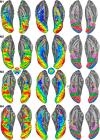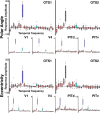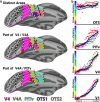Retinotopic Organization of Scene Areas in Macaque Inferior Temporal Cortex
- PMID: 28674177
- PMCID: PMC5546109
- DOI: 10.1523/JNEUROSCI.0569-17.2017
Retinotopic Organization of Scene Areas in Macaque Inferior Temporal Cortex
Abstract
Primates have specialized domains in inferior temporal (IT) cortex that are responsive to particular image categories. Though IT traditionally has been regarded as lacking retinotopy, several recent studies in monkeys have shown that retinotopic maps extend to face patches along the lower bank of the superior temporal sulcus (STS) and neighboring regions of IT cortex. Here, we used fMRI to map the retinotopic organization of medial ventral temporal cortex in four monkeys (2 male and 2 female). We confirm the presence of visual field maps within and around the lower bank of the STS and extend these prior findings to scene-selective cortex in the ventral-most regions of IT. Within the occipitotemporal sulcus (OTS), we identified two retinotopic areas, OTS1 and OTS2. The polar angle representation of OTS2 was a mirror reversal of the OTS1 representation. These regions contained representations of the contralateral periphery and were selectively active for scene versus face, body, or object images. The extent of this retinotopy parallels that in humans and shows that the organization of the scene network is preserved across primate species. In addition retinotopic maps were identified in dorsal extrastriate, posterior parietal, and frontal cortex as well as the thalamus, including both the lateral geniculate nucleus and pulvinar. Together, it appears that most, if not all, of the macaque visual system contains organized representations of visual space.SIGNIFICANCE STATEMENT Primates have specialized domains in inferior temporal (IT) cortex that are responsive to particular image categories. Though retinotopic maps are considered a fundamental organizing principle of posterior visual cortex, IT traditionally has been regarded as lacking retinotopy. Recent imaging studies have demonstrated the presence of several visual field maps within the lateral IT. Using neuroimaging, we found multiple representations of visual space within ventral IT cortex of macaques that included scene-selective cortex. Scene domains were biased toward the peripheral visual field. These data demonstrate the prevalence of visual field maps throughout the primate visual system, including late stages in the ventral visual hierarchy, and support the idea that domains representing different categories are biased toward different parts of the visual field.
Keywords: IT; macaque; organization; retinotopy; scenes; vision.
Copyright © 2017 Arcaro and Livingstone.
Figures











References
Publication types
MeSH terms
Grants and funding
LinkOut - more resources
Full Text Sources
Other Literature Sources
